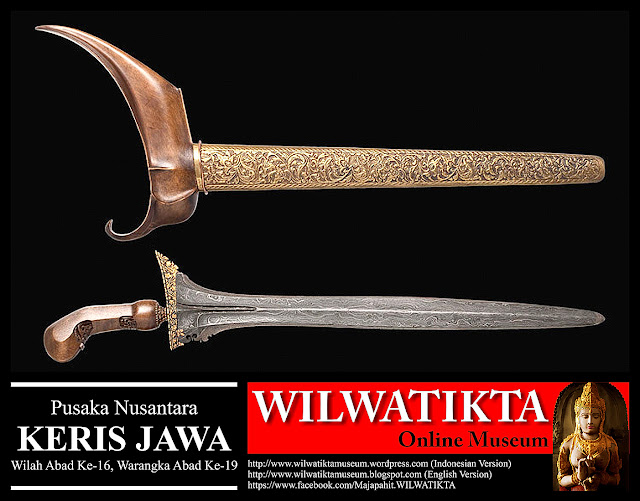Jenis : Tombak Pataka Nagari
Nama : Sang Hyang Baruna
Material : Tembaga
Tombak Pataka ini di buat di era Kerajaan SINGHASARI (abad 12 – 13 Masehi), dan diwarisi oleh Kerajaan WILWATIKTA (MAJAPAHIT). Dipasang di atas kapal yang memimpin rombongan ekspedisi, menandai adanya seseorang diatas kapal tersebut yang mewakili Raja atau Negara. Bendera atau panji yang dipasang bernama : “Getih – Getah Samudra” (lima garis merah dan empat garis putih), sebagai bendera armada militer SINGHASARI / MAJAPAHIT. Sampai saat ini bendera ini dipakai oleh TNI-AL dalam kapal-kapal perangnya di perairan internasional, dengan nama panji : “Ular-ular Tempur”.
Pataka ini di bawa oleh pasukan ekspedisi PAMALAYU dan diserahkan kepada Kerajaan Majapahit sebagai penerus dari Kerajaan Singhasari.
Berkiprah pada “Ekspedisi PAMALAYU (Singhasari)”, “Ekspedisi Duta Besar ADITYAWARMAN ke China (Majapahit)” hal ini dilakukan dua kali, “Ekspedisi NUSANTARA oleh GAJAHMADA (Majapahit)”. Dan eksis sampai saat ini, dilanjutkan oleh TNI-AL sebagai kekuatan maritim Negara Kesatuan Republik Indonesia.
Tombak Pataka ini sekarang berada di :
THE METROPOLITAN MUSEUM OF ART
1000 5th Avenue, New York, NY – USA
Dengan data museum sebagai berikut :
Halberd Head with Naga and Blades
Period: Eastern Javanese period, Singasari kingdom
Date: ca. second half of the 13th century
Culture: Indonesia (Java)
Medium: Copper alloy
Dimensions: H.17 1/2 in. (44.4 cm); Gr. W. 8 1/4 in. (21 cm)
Classification: Metalwork
Credit Line: Samuel Eilenberg Collection, Gift of Samuel Eilenberg, 1996
Accession Number: 1996.468a, b
This artwork is currently on display in Gallery 247
Hal ini cukup mengherankan saya, sebab Amerika Serikat tidak mempunyai benang merah sejarah dengan Indonesia. Mungkin artefak ini diambil oleh pemerintah kolonial Belanda dan dikirim ke Eropa, baru kemudian berpindah tangan ke Amerika Serikat (???).
Janganlah ditangisi bila artefak sejarah kita dimiliki Kolektor dan Museum ASING, mungkin itu dijarah saat masa penjajahan atau dijual orang kita sendiri atau bahkan anak keturunan yang sedang membutuhkan uang.
“AMATI DENGAN SEKSAMA, TANGKAP AURA-NYA. DAN CIPTAKAN YANG LEBIH INDAH DARI ITU. MEREKA TIDAK AKAN PERNAH BISA MENJARAH BAKAT DAN KELUHURAN YANG DIWARISKAN LELUHUR KITA”.
SANG PELOPOR DAN PENERUS PATAKA “SANG HYANG BARUNA”
Dalam menjalankan politik NUSANTARA (penyatuan seluruh kepulauan nusantara di bawah panji Majapahit), terdapat 3 nama besar yang cukup disegani dalam pelaksanaannya.
Yang pertama adalah : ADITYAWARMAN (dengan pangkat tertingi Wredhamantri), adalah keluarga raja yang meniti kariernya di dunia militer sebagai penerus ayahandanya (keluarga Raja Singhasari) MAHESA ANABRANG yang bergelar ADWAYABRAHMA. Kedua-duanya dikenal tangguh di medan pertempuran, jago strategi dan ulet menjalankan misi diplomatik (MAHESA ANABRANG adalah pimpinan misi diplomatik ekspedisi PAMALAYU Singhasari ke Kerajaan DHARMASRAYA, jejak ini diikuti putranya : ADITYAWARMAN yang melakukan “mission imposible” dengan melakukan kunjungan diplomatik ke Kaisaran China. Padahal baru 2 dekade pasukan Tartar ini digempur dalam pertempuran tanah Jawa oleh Raden WIJAYA, dan mereka sedang mempersiapkan gempuran balasan). Kehandalan ADITYAWARMAN sebagai duta lah yang bisa menetralisir keadaan dan bahkan menemukan kesepahaman dalam hubungan antar negara. Baik ayah dan anak ini ketika melakukan tugasnya : membawa Tombak Pataka SANG HYANG BARUNA.
Yang kedua dan ketiga adalah dua serangkai : Panglima Laut Rakarian Tumenggung MPU NALA dan Mahapatih Amangkubhumi GAJAHMADA. Keduanya secara bahu-membahu menjalankan tugas penyatuan nusantara dengan konsisten dibidangnya masing-masing. MPU NALA adalah generasi kedua panglima armada laut, ayahandanya dikenal sebagai panglima laut yang memimpin rombongan pertama ekspedisi Pamalayu Singhasari menuju Kerajaan Tumasik di selat Malaka. Maka penunjukannya sebagai Panglima Laut di era pemerintahan Rani TRIBHUWANA TUNGGADEWI bersifat mutlak, mengingat banyak pelaut-pelaut yang dahulu mengabdi kepada ayahandanya telah bersumpah setia mendukung kepemimpinannya mengarungi samudra. Dikenal jago pertempuran laut dan pandai menyatukan pasukan laut yang berasal dari beberapa negara bawahan.
Mahapatih Amangkubhumi GAJAHMADA adalah tokoh kunci dari politik penyatuan nusantara lewat SUMPAH PALAPAnya. Seorang militer tulen yang memulai karirnya dari bawah sebagai bekel dan dikenal cerdas mempelajari ilmu pemerintahan. Pemikirannya banyak dipengaruhi oleh politik NUSANTARA Kerajaan Singhasari Raja SRI KERTANEGARA dan hal ini cocok dengan pemikiran Rani Majapahit (TRIBHUWANA TUNGGADEWI yang juga cucu dari SRI KERTANEGARA) yang mendapat pemahaman serupa dari ibundanya : DYAH AYU GAYATRI.
Keteguhan hati sang GAJAHMADA dalam mencapai cita-citanya diujinya sendiri dalam berbagai medan pertempuran di separuh kehidupannya. Kemampuannya yang ulet, luwes sekaligus tegas dan tangguh telah mewariskan kepada kita INDONESIA Raya yang luas ini.
Dalam menjalankan ekspedisinya, kapal panglimanya selalu membawa Tombak Pataka Sang Hyang BARUNA dan mengibarkan panji-panji kebesaran Majapahit.
Rupanya perjalanan sejarah tersebut diabadikan secara konsisten oleh TNI-AL sebagai kekuatan maritim INDONESIA. Panji Maritim Majapahit tetap dipakai hingga saat ini, bahkan GAJAHMADA dibuatkan monumennya di Markas Komando TNI-AL Surabaya. Keduanya baik MPU NALA maupun GAJAHMADA, namanya diabadikan sebagai nama kapal perang : KRI. NALA dan KRI. GAJAHMADA.






































